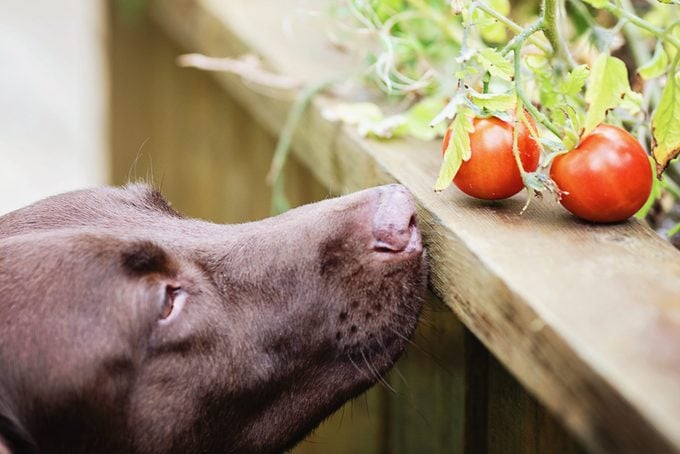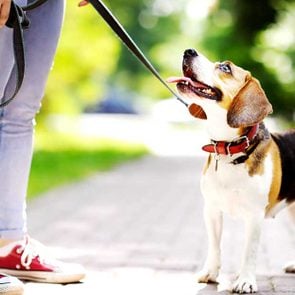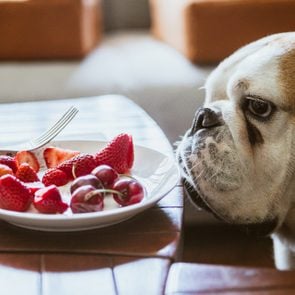Can Dogs Eat Tomatoes?
Updated: Mar. 08, 2022
Tomatoes are a welcome addition to most sandwiches, salads, sauces, and burgers. But can dogs eat tomatoes?
Food for thought
Many people love tomatoes. And many dogs tend to love human food, whether it’s good for them or not.
While nice, red, fully ripened tomato fruit is generally safe for dogs to eat, some parts of the plant can be toxic to dogs. Here’s what the experts need you to know about feeding tomatoes to dogs.
Can dogs eat tomatoes?
Generally speaking, dogs can enjoy the same types of tomatoes—and parts of a tomato—that humans enjoy.
Jerry Klein, DVM, chief veterinary officer of the American Kennel Club (AKC), says you can feed dogs ripe tomato fruit in moderation, but adds that dogs tend not to really like them, they don’t need to eat them, and they may end up with stomach issues.
In other words, since you don’t need to let dogs eat tomatoes, and since some parts of a tomato plant can be dangerous for dogs, it’s likely best to avoid feeding dogs tomatoes altogether.
Are there parts of a tomato plant dogs should not eat?
Experts make clear to only feed a dog fully ripened tomato fruit, not unripe tomatoes or the plant’s stems or leaves. As a general rule of thumb, a dog should not eat any green parts of a tomato.
“Unripe fruit or plant material can cause vomiting and diarrhea,” says Tina Wismer, DVM, the senior director of toxicology for the American Society for the Prevention of Cruelty to Animals (ASPCA) Animal Poison Control Center.
“The toxic compound is called tomatine, and it decreases in the fruit as it ripens.”
According to the AKC, tomatoes also contain a toxin called solanine, which is also primarily concentrated in the green part of tomatoes, such as the stems, leaves, and unripened fruit. It can be dangerous for dogs in large quantities.
That means you should not let a dog eat a growing tomato or other parts of the plant, and dog owners who grow tomatoes may want to take some precautions against curious canines.
That could mean planting tomatoes somewhere your dog can’t access, or it could just mean placing tomato cages or other fencing around the plants (which is often a good idea for supporting tomato vines anyway).

Can dogs eat tomato sauce?
Experts say as long as tomato sauce is from the fully ripe fruit—i.e., red tomatoes—it should be safe for a dog to eat in moderation.
It’s probably best to avoid pre-made, packaged, or canned tomato sauce, however, because it tends to contain ingredients that are generally not good for dogs, such as sodium (salt), sugar, corn syrup, corn starch, and preservatives.
What if a dog eats too much tomato fruit, stems, or leaves?
The AKC says if dogs eat too many tomatoes or green parts of a tomato, they may experience tomatine poisoning.
Symptoms of tomatine poisoning include:
- gastrointestinal symptoms, such as vomiting and diarrhea
- tremors
- seizures
- unexplained muscle weakness
- loss of coordination
- heart problems
What to do if a dog ate green tomatoes, tomato plants, or has signs of tomatine poisoning
If a dog has eaten green tomatoes, or green parts of a tomato plant, experts recommend monitoring closely for symptoms of tomatine poisoning. Contact your veterinarian as soon as possible if symptoms occur, or contact Animal Poison Control at 888-426-4435 for advice on how to proceed.
If a dog does not develop any symptoms and seems fine, they likely did not consume enough toxins to pose a danger and should safely pass the toxins in their urine or feces.
If a dog does have tomatine poisoning, a veterinarian will typically administer formulas to induce vomiting or chemicals that help remove the toxin from the dog’s system. According to the AKC, in most cases, the prognosis for dogs with tomatine poisoning is generally good, and dogs tend to recover fully with treatment.
How should you feed a dog tomatoes?
Experts say you should prepare tomatoes for dogs the same way you would for humans. That means washing the tomatoes, removing any green parts such as the stems or leaves, and cutting them up into bite-sized pieces to avoid the risk of choking.
“Wash all fruit before eating,” Klein says. Organic fruit may have residue from organic fertilizers, which may have fecal debris, he notes, while non-organic fruits may contain pesticides or other harmful chemical residues. He adds that it’s best to chop fruits into chewable pieces relative to the size of the dog.
How much tomato should a dog eat?
According to the experts, always feed a dog tomato or tomato products like tomato sauce in moderation or in small quantities as a treat. Eating a lot of tomatoes can also cause mild digestive issues, especially if a dog is not accustomed to eating it.
What other human foods can dogs eat?
A majority of human foods are also safe for dogs. Here are some examples of foods dogs can eat (in moderation):
- cranberries, blueberries, strawberries, raspberries
- melons
- peanuts and cashews
- corn
- cooked eggs
- cooked meat, fish, and seafood
- broccoli and cauliflower
- celery
- lettuce
- wheat, grains, and pulses
- yogurt
- cherries
- mango
- kiwi
- bananas
- cucumber
- pineapple
- carrots
- green beans
- Brussels sprouts
- spinach
- peas
What human foods can dogs not eat?
Some foods contain toxins that can damage or destroy healthy cells in dogs. Other foods are not safe for a dog to eat because they contain parts that a dog cannot digest, has trouble digesting, or can choke on, or that may damage the esophagus.
Here are some foods to never feed a dog:
- fruit and vegetable pits, cores, pith, skins, peels, stones, or other parts that humans cannot eat safely
- apple and mustard seeds
- most nuts, including macadamia nuts, almonds, Brazil nuts, and walnuts
- cooking oils
- seasonings
- garlic
- onions, leeks, and chives
- chocolate and candies
- ice cream and milk
- raw meat, fish, eggs, seafood, and bones
- raw potatoes
- avocados
- grapes, raisins, and currants
- asparagus
- mushrooms
- caffeine
- alcohol
- citrus fruits
- coconut fruit, oil, or water
- salty foods
- packaged foods
- yeast dough
- artificial sweeteners or preservatives
- household plants or flowers
- gum
- hops
- moldy, rotten, or spoiled foods
- rhubarb leaves
- plant leaves, stems, or vines
Advice for feeding dogs human foods
Remove any peels or skin before feeding dogs human foods like fruits or vegetables. Always wash these foods thoroughly, and remove any pits, stems, seeds, cores, stones, pith, spikes, or any green or inedible parts of the plant.
If you would normally cook a fruit or vegetable before eating it yourself, also make sure to cook it before feeding it to a dog.
Experts recommend that treats of any kind should only account for 5 to 10 percent of a dog’s total diet or daily caloric intake. Wismer says dogs should get most of their nutrition from their regular diet or foods designed for dogs.
While most fruits and vegetables do contain important nutrients that can be beneficial for a dog, many also contain sugar or other components that, in large quantities, can raise the risk of conditions such as diabetes or cardiovascular disease.


















